Corporations Law 24: Analysis of Tort Law Case Studies
VerifiedAdded on 2022/11/29
|24
|6303
|302
Essay
AI Summary
This assignment provides a comprehensive analysis of tort law, specifically focusing on pure economic loss arising from advice and statements, and the principles governing the recovery of damages in such cases. It examines the concept of "assumption of responsibility" and the implications of non-contractual disclaimer notices, offering insights into the balance between claimants' rights and defendants' interests. The assignment also delves into a case study involving a car accident, applying the principles of negligence, duty of care (including the Caparo test), and breach of duty to determine liability and potential damages. Key legal concepts such as foreseeability, proximity, and the objective test for breach of duty are explored, supported by relevant case law like Donoghue v Stevenson and Caparo Industries Plc v Dickman, providing a thorough understanding of the legal principles involved.
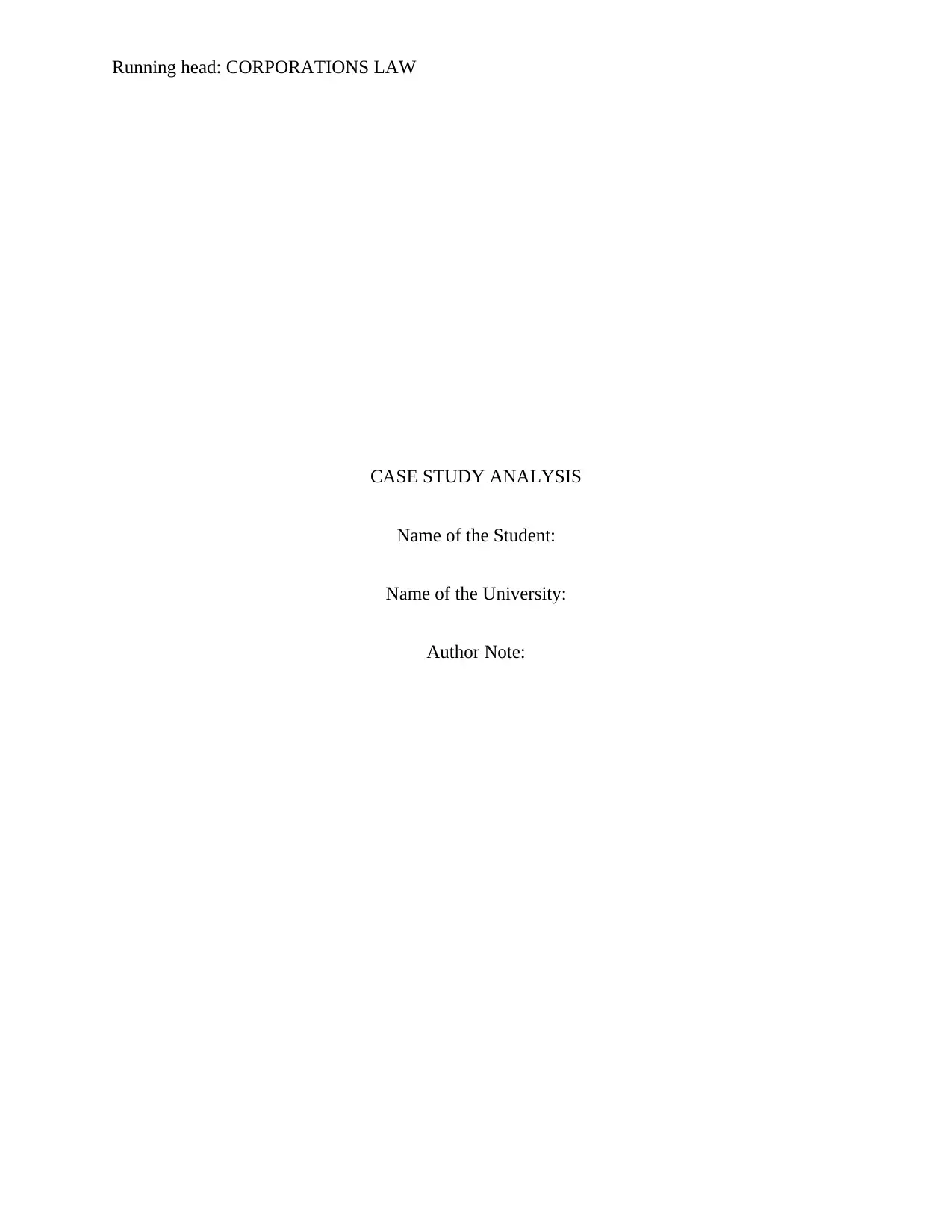
Running head: CORPORATIONS LAW
CASE STUDY ANALYSIS
Name of the Student:
Name of the University:
Author Note:
CASE STUDY ANALYSIS
Name of the Student:
Name of the University:
Author Note:
Paraphrase This Document
Need a fresh take? Get an instant paraphrase of this document with our AI Paraphraser
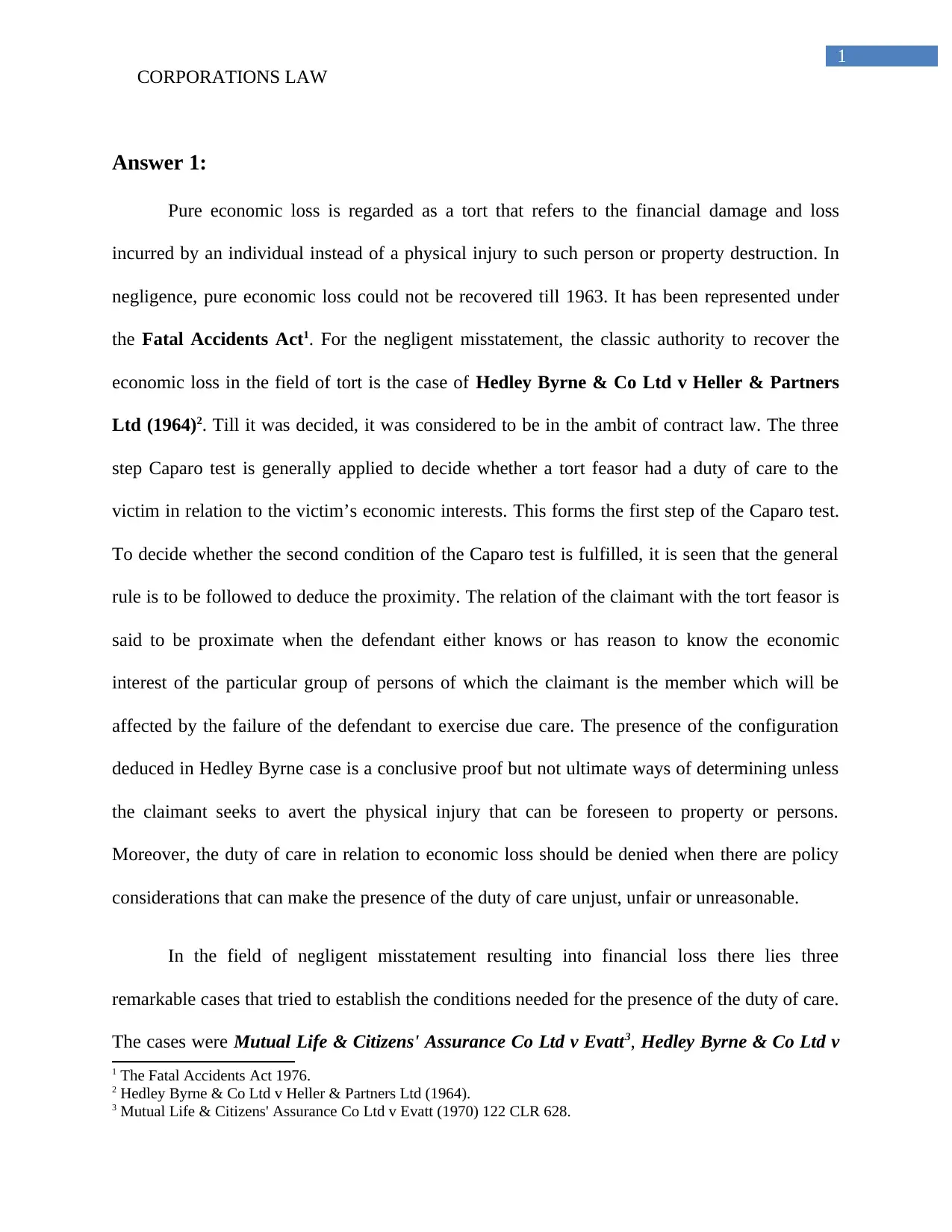
1
CORPORATIONS LAW
Answer 1:
Pure economic loss is regarded as a tort that refers to the financial damage and loss
incurred by an individual instead of a physical injury to such person or property destruction. In
negligence, pure economic loss could not be recovered till 1963. It has been represented under
the Fatal Accidents Act1. For the negligent misstatement, the classic authority to recover the
economic loss in the field of tort is the case of Hedley Byrne & Co Ltd v Heller & Partners
Ltd (1964)2. Till it was decided, it was considered to be in the ambit of contract law. The three
step Caparo test is generally applied to decide whether a tort feasor had a duty of care to the
victim in relation to the victim’s economic interests. This forms the first step of the Caparo test.
To decide whether the second condition of the Caparo test is fulfilled, it is seen that the general
rule is to be followed to deduce the proximity. The relation of the claimant with the tort feasor is
said to be proximate when the defendant either knows or has reason to know the economic
interest of the particular group of persons of which the claimant is the member which will be
affected by the failure of the defendant to exercise due care. The presence of the configuration
deduced in Hedley Byrne case is a conclusive proof but not ultimate ways of determining unless
the claimant seeks to avert the physical injury that can be foreseen to property or persons.
Moreover, the duty of care in relation to economic loss should be denied when there are policy
considerations that can make the presence of the duty of care unjust, unfair or unreasonable.
In the field of negligent misstatement resulting into financial loss there lies three
remarkable cases that tried to establish the conditions needed for the presence of the duty of care.
The cases were Mutual Life & Citizens' Assurance Co Ltd v Evatt3, Hedley Byrne & Co Ltd v
1 The Fatal Accidents Act 1976.
2 Hedley Byrne & Co Ltd v Heller & Partners Ltd (1964).
3 Mutual Life & Citizens' Assurance Co Ltd v Evatt (1970) 122 CLR 628.
CORPORATIONS LAW
Answer 1:
Pure economic loss is regarded as a tort that refers to the financial damage and loss
incurred by an individual instead of a physical injury to such person or property destruction. In
negligence, pure economic loss could not be recovered till 1963. It has been represented under
the Fatal Accidents Act1. For the negligent misstatement, the classic authority to recover the
economic loss in the field of tort is the case of Hedley Byrne & Co Ltd v Heller & Partners
Ltd (1964)2. Till it was decided, it was considered to be in the ambit of contract law. The three
step Caparo test is generally applied to decide whether a tort feasor had a duty of care to the
victim in relation to the victim’s economic interests. This forms the first step of the Caparo test.
To decide whether the second condition of the Caparo test is fulfilled, it is seen that the general
rule is to be followed to deduce the proximity. The relation of the claimant with the tort feasor is
said to be proximate when the defendant either knows or has reason to know the economic
interest of the particular group of persons of which the claimant is the member which will be
affected by the failure of the defendant to exercise due care. The presence of the configuration
deduced in Hedley Byrne case is a conclusive proof but not ultimate ways of determining unless
the claimant seeks to avert the physical injury that can be foreseen to property or persons.
Moreover, the duty of care in relation to economic loss should be denied when there are policy
considerations that can make the presence of the duty of care unjust, unfair or unreasonable.
In the field of negligent misstatement resulting into financial loss there lies three
remarkable cases that tried to establish the conditions needed for the presence of the duty of care.
The cases were Mutual Life & Citizens' Assurance Co Ltd v Evatt3, Hedley Byrne & Co Ltd v
1 The Fatal Accidents Act 1976.
2 Hedley Byrne & Co Ltd v Heller & Partners Ltd (1964).
3 Mutual Life & Citizens' Assurance Co Ltd v Evatt (1970) 122 CLR 628.
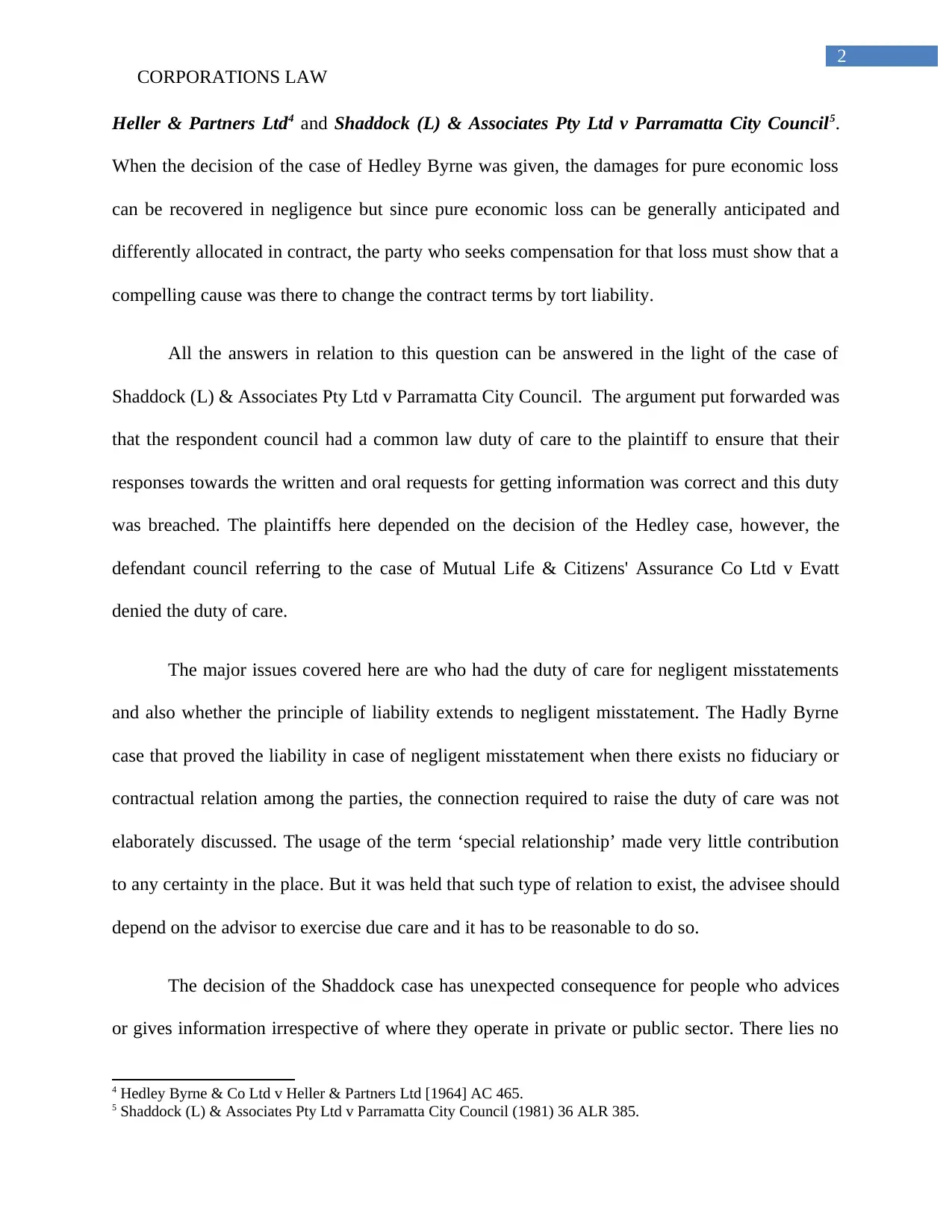
2
CORPORATIONS LAW
Heller & Partners Ltd4 and Shaddock (L) & Associates Pty Ltd v Parramatta City Council5.
When the decision of the case of Hedley Byrne was given, the damages for pure economic loss
can be recovered in negligence but since pure economic loss can be generally anticipated and
differently allocated in contract, the party who seeks compensation for that loss must show that a
compelling cause was there to change the contract terms by tort liability.
All the answers in relation to this question can be answered in the light of the case of
Shaddock (L) & Associates Pty Ltd v Parramatta City Council. The argument put forwarded was
that the respondent council had a common law duty of care to the plaintiff to ensure that their
responses towards the written and oral requests for getting information was correct and this duty
was breached. The plaintiffs here depended on the decision of the Hedley case, however, the
defendant council referring to the case of Mutual Life & Citizens' Assurance Co Ltd v Evatt
denied the duty of care.
The major issues covered here are who had the duty of care for negligent misstatements
and also whether the principle of liability extends to negligent misstatement. The Hadly Byrne
case that proved the liability in case of negligent misstatement when there exists no fiduciary or
contractual relation among the parties, the connection required to raise the duty of care was not
elaborately discussed. The usage of the term ‘special relationship’ made very little contribution
to any certainty in the place. But it was held that such type of relation to exist, the advisee should
depend on the advisor to exercise due care and it has to be reasonable to do so.
The decision of the Shaddock case has unexpected consequence for people who advices
or gives information irrespective of where they operate in private or public sector. There lies no
4 Hedley Byrne & Co Ltd v Heller & Partners Ltd [1964] AC 465.
5 Shaddock (L) & Associates Pty Ltd v Parramatta City Council (1981) 36 ALR 385.
CORPORATIONS LAW
Heller & Partners Ltd4 and Shaddock (L) & Associates Pty Ltd v Parramatta City Council5.
When the decision of the case of Hedley Byrne was given, the damages for pure economic loss
can be recovered in negligence but since pure economic loss can be generally anticipated and
differently allocated in contract, the party who seeks compensation for that loss must show that a
compelling cause was there to change the contract terms by tort liability.
All the answers in relation to this question can be answered in the light of the case of
Shaddock (L) & Associates Pty Ltd v Parramatta City Council. The argument put forwarded was
that the respondent council had a common law duty of care to the plaintiff to ensure that their
responses towards the written and oral requests for getting information was correct and this duty
was breached. The plaintiffs here depended on the decision of the Hedley case, however, the
defendant council referring to the case of Mutual Life & Citizens' Assurance Co Ltd v Evatt
denied the duty of care.
The major issues covered here are who had the duty of care for negligent misstatements
and also whether the principle of liability extends to negligent misstatement. The Hadly Byrne
case that proved the liability in case of negligent misstatement when there exists no fiduciary or
contractual relation among the parties, the connection required to raise the duty of care was not
elaborately discussed. The usage of the term ‘special relationship’ made very little contribution
to any certainty in the place. But it was held that such type of relation to exist, the advisee should
depend on the advisor to exercise due care and it has to be reasonable to do so.
The decision of the Shaddock case has unexpected consequence for people who advices
or gives information irrespective of where they operate in private or public sector. There lies no
4 Hedley Byrne & Co Ltd v Heller & Partners Ltd [1964] AC 465.
5 Shaddock (L) & Associates Pty Ltd v Parramatta City Council (1981) 36 ALR 385.
⊘ This is a preview!⊘
Do you want full access?
Subscribe today to unlock all pages.

Trusted by 1+ million students worldwide
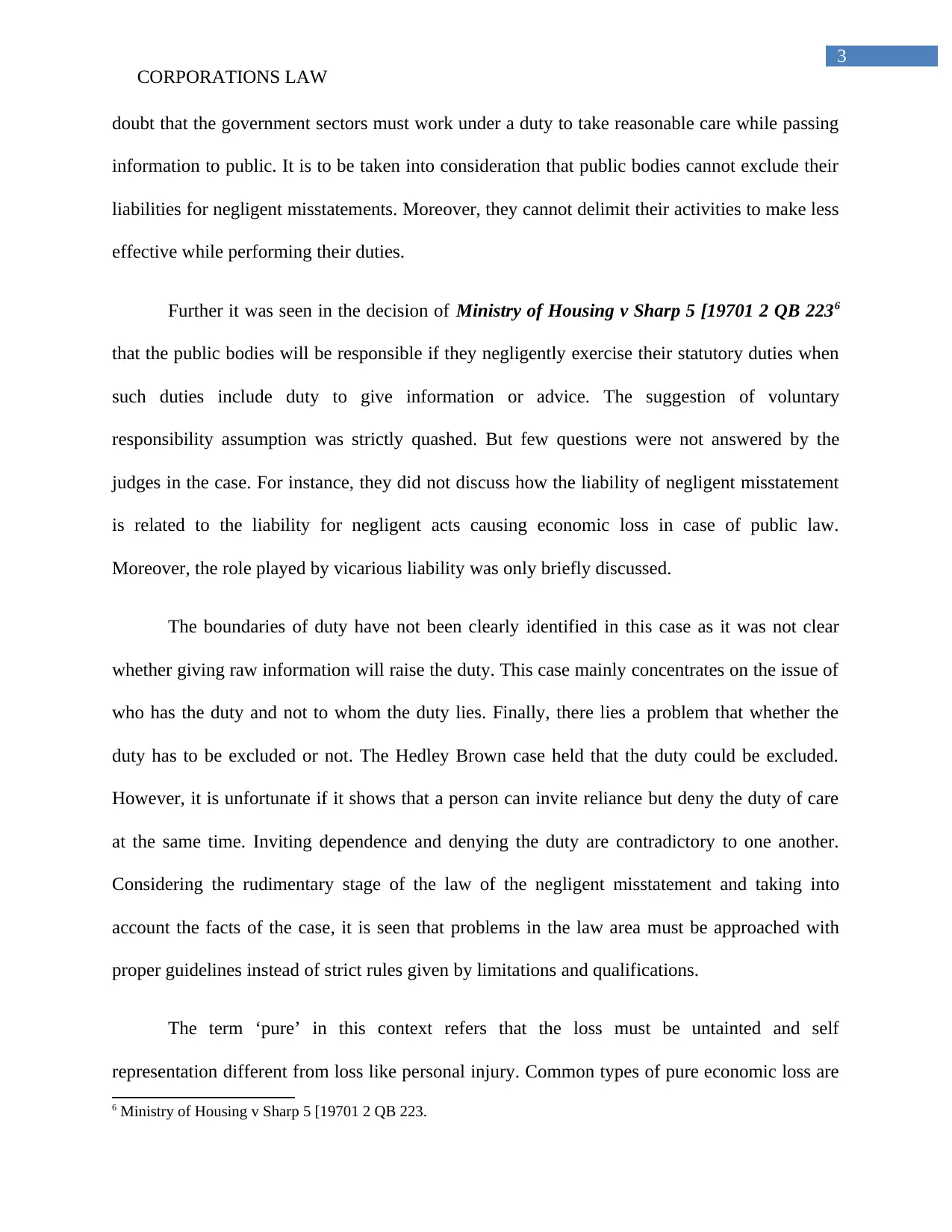
3
CORPORATIONS LAW
doubt that the government sectors must work under a duty to take reasonable care while passing
information to public. It is to be taken into consideration that public bodies cannot exclude their
liabilities for negligent misstatements. Moreover, they cannot delimit their activities to make less
effective while performing their duties.
Further it was seen in the decision of Ministry of Housing v Sharp 5 [19701 2 QB 2236
that the public bodies will be responsible if they negligently exercise their statutory duties when
such duties include duty to give information or advice. The suggestion of voluntary
responsibility assumption was strictly quashed. But few questions were not answered by the
judges in the case. For instance, they did not discuss how the liability of negligent misstatement
is related to the liability for negligent acts causing economic loss in case of public law.
Moreover, the role played by vicarious liability was only briefly discussed.
The boundaries of duty have not been clearly identified in this case as it was not clear
whether giving raw information will raise the duty. This case mainly concentrates on the issue of
who has the duty and not to whom the duty lies. Finally, there lies a problem that whether the
duty has to be excluded or not. The Hedley Brown case held that the duty could be excluded.
However, it is unfortunate if it shows that a person can invite reliance but deny the duty of care
at the same time. Inviting dependence and denying the duty are contradictory to one another.
Considering the rudimentary stage of the law of the negligent misstatement and taking into
account the facts of the case, it is seen that problems in the law area must be approached with
proper guidelines instead of strict rules given by limitations and qualifications.
The term ‘pure’ in this context refers that the loss must be untainted and self
representation different from loss like personal injury. Common types of pure economic loss are
6 Ministry of Housing v Sharp 5 [19701 2 QB 223.
CORPORATIONS LAW
doubt that the government sectors must work under a duty to take reasonable care while passing
information to public. It is to be taken into consideration that public bodies cannot exclude their
liabilities for negligent misstatements. Moreover, they cannot delimit their activities to make less
effective while performing their duties.
Further it was seen in the decision of Ministry of Housing v Sharp 5 [19701 2 QB 2236
that the public bodies will be responsible if they negligently exercise their statutory duties when
such duties include duty to give information or advice. The suggestion of voluntary
responsibility assumption was strictly quashed. But few questions were not answered by the
judges in the case. For instance, they did not discuss how the liability of negligent misstatement
is related to the liability for negligent acts causing economic loss in case of public law.
Moreover, the role played by vicarious liability was only briefly discussed.
The boundaries of duty have not been clearly identified in this case as it was not clear
whether giving raw information will raise the duty. This case mainly concentrates on the issue of
who has the duty and not to whom the duty lies. Finally, there lies a problem that whether the
duty has to be excluded or not. The Hedley Brown case held that the duty could be excluded.
However, it is unfortunate if it shows that a person can invite reliance but deny the duty of care
at the same time. Inviting dependence and denying the duty are contradictory to one another.
Considering the rudimentary stage of the law of the negligent misstatement and taking into
account the facts of the case, it is seen that problems in the law area must be approached with
proper guidelines instead of strict rules given by limitations and qualifications.
The term ‘pure’ in this context refers that the loss must be untainted and self
representation different from loss like personal injury. Common types of pure economic loss are
6 Ministry of Housing v Sharp 5 [19701 2 QB 223.
Paraphrase This Document
Need a fresh take? Get an instant paraphrase of this document with our AI Paraphraser
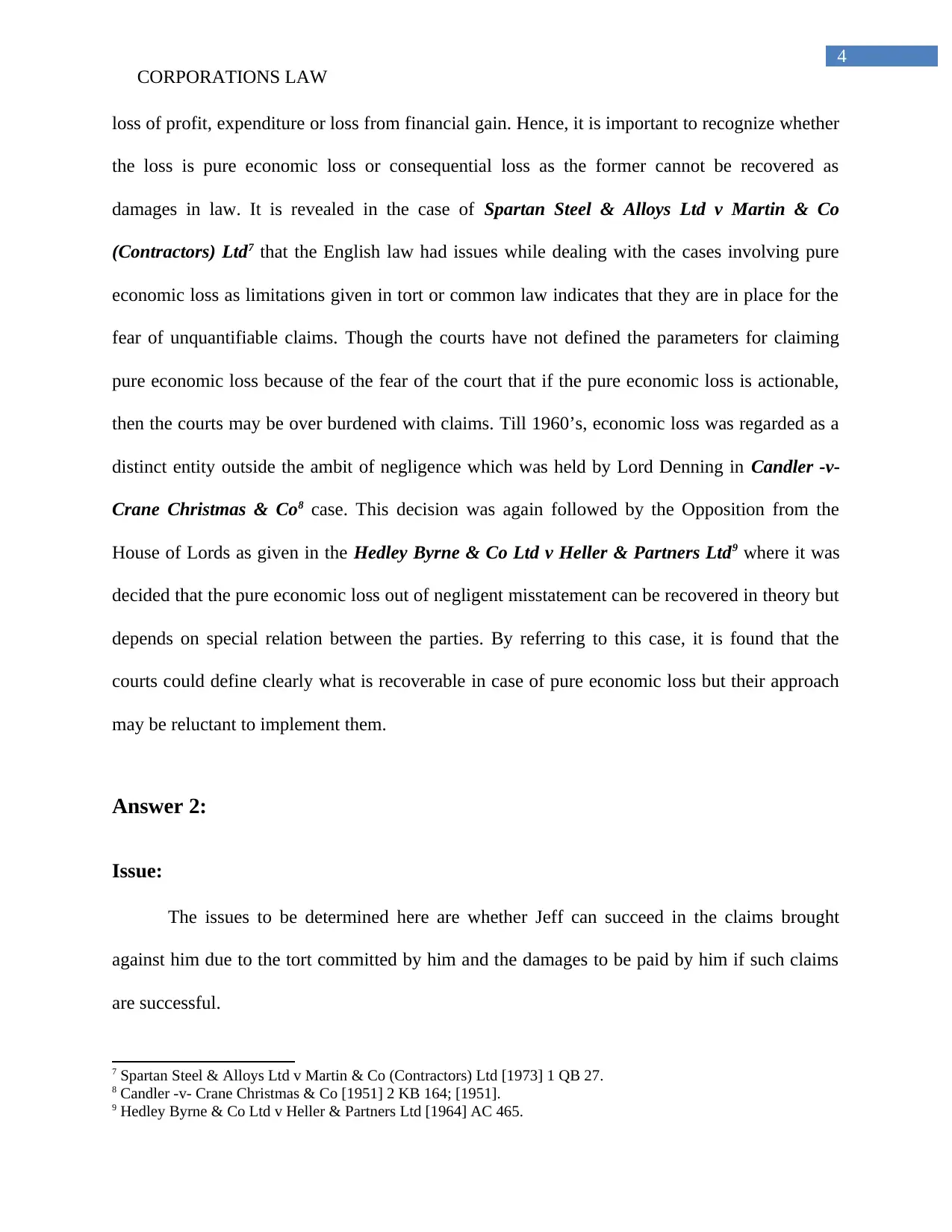
4
CORPORATIONS LAW
loss of profit, expenditure or loss from financial gain. Hence, it is important to recognize whether
the loss is pure economic loss or consequential loss as the former cannot be recovered as
damages in law. It is revealed in the case of Spartan Steel & Alloys Ltd v Martin & Co
(Contractors) Ltd7 that the English law had issues while dealing with the cases involving pure
economic loss as limitations given in tort or common law indicates that they are in place for the
fear of unquantifiable claims. Though the courts have not defined the parameters for claiming
pure economic loss because of the fear of the court that if the pure economic loss is actionable,
then the courts may be over burdened with claims. Till 1960’s, economic loss was regarded as a
distinct entity outside the ambit of negligence which was held by Lord Denning in Candler -v-
Crane Christmas & Co8 case. This decision was again followed by the Opposition from the
House of Lords as given in the Hedley Byrne & Co Ltd v Heller & Partners Ltd9 where it was
decided that the pure economic loss out of negligent misstatement can be recovered in theory but
depends on special relation between the parties. By referring to this case, it is found that the
courts could define clearly what is recoverable in case of pure economic loss but their approach
may be reluctant to implement them.
Answer 2:
Issue:
The issues to be determined here are whether Jeff can succeed in the claims brought
against him due to the tort committed by him and the damages to be paid by him if such claims
are successful.
7 Spartan Steel & Alloys Ltd v Martin & Co (Contractors) Ltd [1973] 1 QB 27.
8 Candler -v- Crane Christmas & Co [1951] 2 KB 164; [1951].
9 Hedley Byrne & Co Ltd v Heller & Partners Ltd [1964] AC 465.
CORPORATIONS LAW
loss of profit, expenditure or loss from financial gain. Hence, it is important to recognize whether
the loss is pure economic loss or consequential loss as the former cannot be recovered as
damages in law. It is revealed in the case of Spartan Steel & Alloys Ltd v Martin & Co
(Contractors) Ltd7 that the English law had issues while dealing with the cases involving pure
economic loss as limitations given in tort or common law indicates that they are in place for the
fear of unquantifiable claims. Though the courts have not defined the parameters for claiming
pure economic loss because of the fear of the court that if the pure economic loss is actionable,
then the courts may be over burdened with claims. Till 1960’s, economic loss was regarded as a
distinct entity outside the ambit of negligence which was held by Lord Denning in Candler -v-
Crane Christmas & Co8 case. This decision was again followed by the Opposition from the
House of Lords as given in the Hedley Byrne & Co Ltd v Heller & Partners Ltd9 where it was
decided that the pure economic loss out of negligent misstatement can be recovered in theory but
depends on special relation between the parties. By referring to this case, it is found that the
courts could define clearly what is recoverable in case of pure economic loss but their approach
may be reluctant to implement them.
Answer 2:
Issue:
The issues to be determined here are whether Jeff can succeed in the claims brought
against him due to the tort committed by him and the damages to be paid by him if such claims
are successful.
7 Spartan Steel & Alloys Ltd v Martin & Co (Contractors) Ltd [1973] 1 QB 27.
8 Candler -v- Crane Christmas & Co [1951] 2 KB 164; [1951].
9 Hedley Byrne & Co Ltd v Heller & Partners Ltd [1964] AC 465.
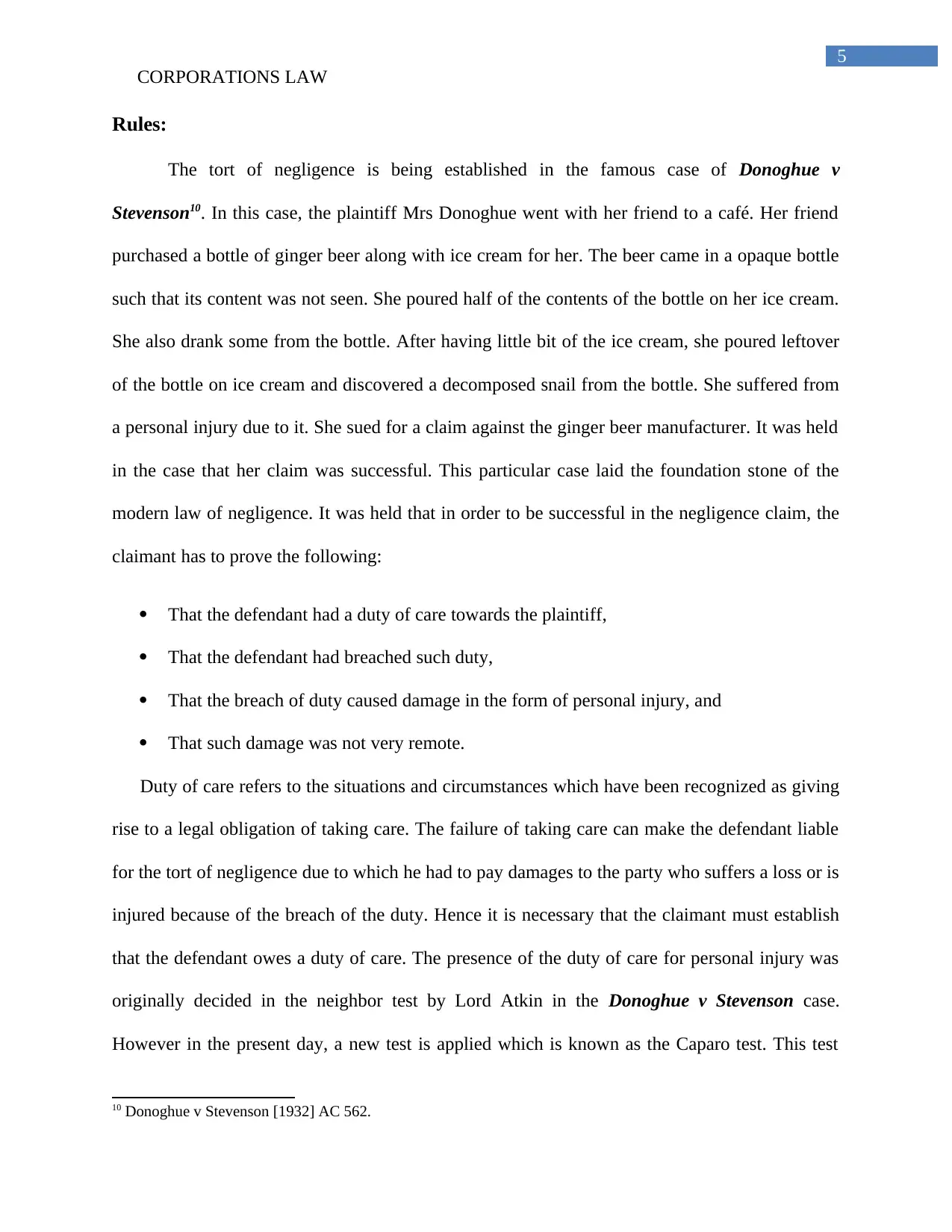
5
CORPORATIONS LAW
Rules:
The tort of negligence is being established in the famous case of Donoghue v
Stevenson10. In this case, the plaintiff Mrs Donoghue went with her friend to a café. Her friend
purchased a bottle of ginger beer along with ice cream for her. The beer came in a opaque bottle
such that its content was not seen. She poured half of the contents of the bottle on her ice cream.
She also drank some from the bottle. After having little bit of the ice cream, she poured leftover
of the bottle on ice cream and discovered a decomposed snail from the bottle. She suffered from
a personal injury due to it. She sued for a claim against the ginger beer manufacturer. It was held
in the case that her claim was successful. This particular case laid the foundation stone of the
modern law of negligence. It was held that in order to be successful in the negligence claim, the
claimant has to prove the following:
That the defendant had a duty of care towards the plaintiff,
That the defendant had breached such duty,
That the breach of duty caused damage in the form of personal injury, and
That such damage was not very remote.
Duty of care refers to the situations and circumstances which have been recognized as giving
rise to a legal obligation of taking care. The failure of taking care can make the defendant liable
for the tort of negligence due to which he had to pay damages to the party who suffers a loss or is
injured because of the breach of the duty. Hence it is necessary that the claimant must establish
that the defendant owes a duty of care. The presence of the duty of care for personal injury was
originally decided in the neighbor test by Lord Atkin in the Donoghue v Stevenson case.
However in the present day, a new test is applied which is known as the Caparo test. This test
10 Donoghue v Stevenson [1932] AC 562.
CORPORATIONS LAW
Rules:
The tort of negligence is being established in the famous case of Donoghue v
Stevenson10. In this case, the plaintiff Mrs Donoghue went with her friend to a café. Her friend
purchased a bottle of ginger beer along with ice cream for her. The beer came in a opaque bottle
such that its content was not seen. She poured half of the contents of the bottle on her ice cream.
She also drank some from the bottle. After having little bit of the ice cream, she poured leftover
of the bottle on ice cream and discovered a decomposed snail from the bottle. She suffered from
a personal injury due to it. She sued for a claim against the ginger beer manufacturer. It was held
in the case that her claim was successful. This particular case laid the foundation stone of the
modern law of negligence. It was held that in order to be successful in the negligence claim, the
claimant has to prove the following:
That the defendant had a duty of care towards the plaintiff,
That the defendant had breached such duty,
That the breach of duty caused damage in the form of personal injury, and
That such damage was not very remote.
Duty of care refers to the situations and circumstances which have been recognized as giving
rise to a legal obligation of taking care. The failure of taking care can make the defendant liable
for the tort of negligence due to which he had to pay damages to the party who suffers a loss or is
injured because of the breach of the duty. Hence it is necessary that the claimant must establish
that the defendant owes a duty of care. The presence of the duty of care for personal injury was
originally decided in the neighbor test by Lord Atkin in the Donoghue v Stevenson case.
However in the present day, a new test is applied which is known as the Caparo test. This test
10 Donoghue v Stevenson [1932] AC 562.
⊘ This is a preview!⊘
Do you want full access?
Subscribe today to unlock all pages.

Trusted by 1+ million students worldwide

6
CORPORATIONS LAW
was developed in the Caparo Industries Plc v Dickman11. It is a three stage test that imposes the
duty of care. Under the Caparo test, the claimant has to establish the following in order to prove
his claim for damages;
That the harm was foreseeable reasonably,
That there lies a proximity relationship,
That it is just, fair and also reasonable to impose the duty of care.
Firstly, the claimant must prove that for applying the reasonable foresight in establishing a
duty of care as construed in the Home Office v Dorset Yacht Co Ltd12 case. In order to establish
the proximate relationship, the case of Bourhill v Young13 can be referred. Thus it is required to
prove three stages of Caparo test in order to prove that the defendant had a duty of care towards
the claimant.
The second step is to prove the breach of duty. When the defendant failed to meet the
standard care required by law, he will be liable for it. If it is proved by the Caparo test that the
defendant had a duty of care, then the claimant must show that the defendant had breached his
duty by applying the objective test. The test is variable and dependent on the facts of each case.
In the objective test, the courts weigh up four factors;
o Likelihood of the harm:
It is not required that the defendant must not guard against the events that cannot
be foreseen as entrenched in the case of Roe v Minister of Health14.
o Seriousness of the harm:
11 Caparo Industries Plc v Dickman [1990] 2 AC 605.
12 Home Office v Dorset Yacht Co Ltd [1970] AC 1004.
13 Bourhill v Young [1943] AC 92.
14 Roe v Minister of Health [1954] 2 WLR 915.
CORPORATIONS LAW
was developed in the Caparo Industries Plc v Dickman11. It is a three stage test that imposes the
duty of care. Under the Caparo test, the claimant has to establish the following in order to prove
his claim for damages;
That the harm was foreseeable reasonably,
That there lies a proximity relationship,
That it is just, fair and also reasonable to impose the duty of care.
Firstly, the claimant must prove that for applying the reasonable foresight in establishing a
duty of care as construed in the Home Office v Dorset Yacht Co Ltd12 case. In order to establish
the proximate relationship, the case of Bourhill v Young13 can be referred. Thus it is required to
prove three stages of Caparo test in order to prove that the defendant had a duty of care towards
the claimant.
The second step is to prove the breach of duty. When the defendant failed to meet the
standard care required by law, he will be liable for it. If it is proved by the Caparo test that the
defendant had a duty of care, then the claimant must show that the defendant had breached his
duty by applying the objective test. The test is variable and dependent on the facts of each case.
In the objective test, the courts weigh up four factors;
o Likelihood of the harm:
It is not required that the defendant must not guard against the events that cannot
be foreseen as entrenched in the case of Roe v Minister of Health14.
o Seriousness of the harm:
11 Caparo Industries Plc v Dickman [1990] 2 AC 605.
12 Home Office v Dorset Yacht Co Ltd [1970] AC 1004.
13 Bourhill v Young [1943] AC 92.
14 Roe v Minister of Health [1954] 2 WLR 915.
Paraphrase This Document
Need a fresh take? Get an instant paraphrase of this document with our AI Paraphraser
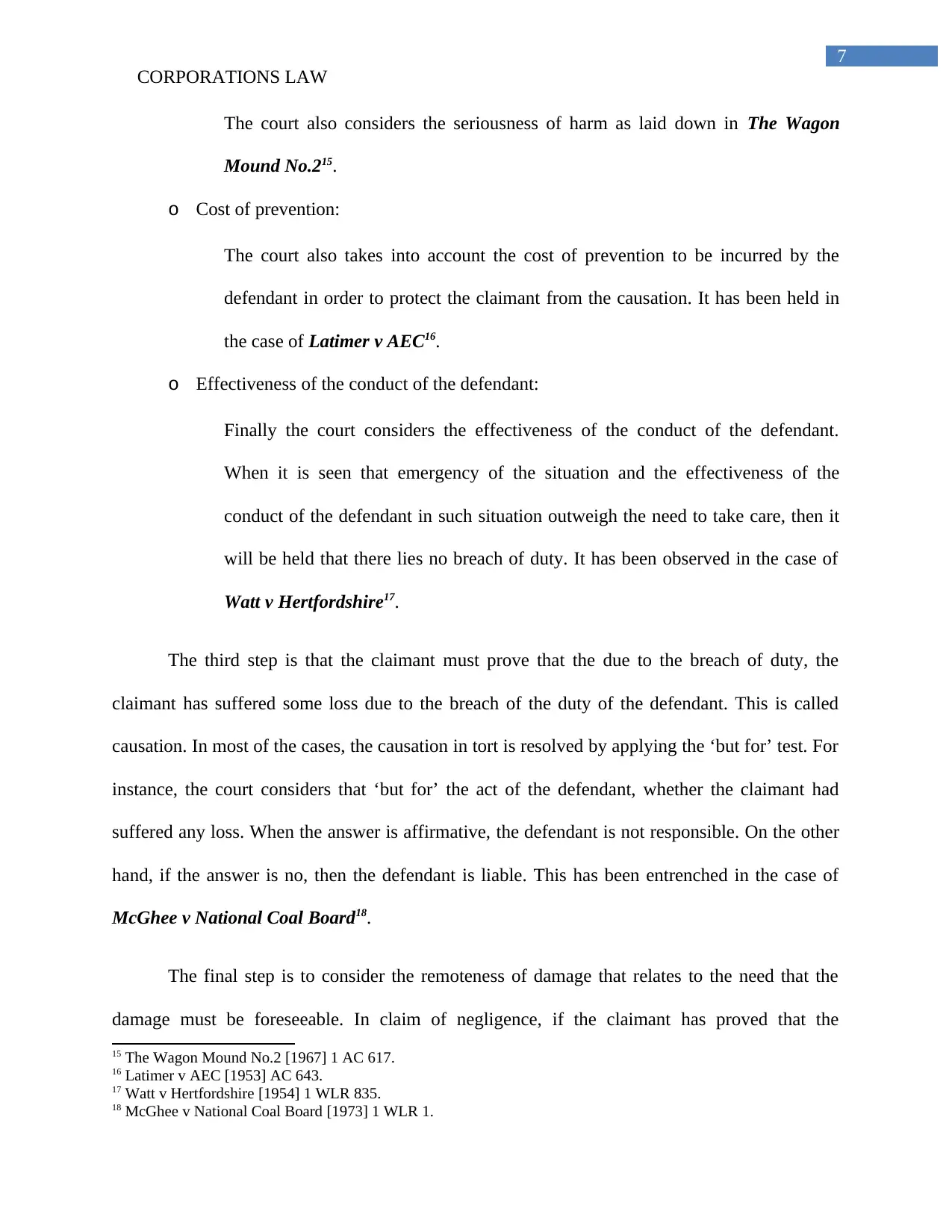
7
CORPORATIONS LAW
The court also considers the seriousness of harm as laid down in The Wagon
Mound No.215.
o Cost of prevention:
The court also takes into account the cost of prevention to be incurred by the
defendant in order to protect the claimant from the causation. It has been held in
the case of Latimer v AEC16.
o Effectiveness of the conduct of the defendant:
Finally the court considers the effectiveness of the conduct of the defendant.
When it is seen that emergency of the situation and the effectiveness of the
conduct of the defendant in such situation outweigh the need to take care, then it
will be held that there lies no breach of duty. It has been observed in the case of
Watt v Hertfordshire17.
The third step is that the claimant must prove that the due to the breach of duty, the
claimant has suffered some loss due to the breach of the duty of the defendant. This is called
causation. In most of the cases, the causation in tort is resolved by applying the ‘but for’ test. For
instance, the court considers that ‘but for’ the act of the defendant, whether the claimant had
suffered any loss. When the answer is affirmative, the defendant is not responsible. On the other
hand, if the answer is no, then the defendant is liable. This has been entrenched in the case of
McGhee v National Coal Board18.
The final step is to consider the remoteness of damage that relates to the need that the
damage must be foreseeable. In claim of negligence, if the claimant has proved that the
15 The Wagon Mound No.2 [1967] 1 AC 617.
16 Latimer v AEC [1953] AC 643.
17 Watt v Hertfordshire [1954] 1 WLR 835.
18 McGhee v National Coal Board [1973] 1 WLR 1.
CORPORATIONS LAW
The court also considers the seriousness of harm as laid down in The Wagon
Mound No.215.
o Cost of prevention:
The court also takes into account the cost of prevention to be incurred by the
defendant in order to protect the claimant from the causation. It has been held in
the case of Latimer v AEC16.
o Effectiveness of the conduct of the defendant:
Finally the court considers the effectiveness of the conduct of the defendant.
When it is seen that emergency of the situation and the effectiveness of the
conduct of the defendant in such situation outweigh the need to take care, then it
will be held that there lies no breach of duty. It has been observed in the case of
Watt v Hertfordshire17.
The third step is that the claimant must prove that the due to the breach of duty, the
claimant has suffered some loss due to the breach of the duty of the defendant. This is called
causation. In most of the cases, the causation in tort is resolved by applying the ‘but for’ test. For
instance, the court considers that ‘but for’ the act of the defendant, whether the claimant had
suffered any loss. When the answer is affirmative, the defendant is not responsible. On the other
hand, if the answer is no, then the defendant is liable. This has been entrenched in the case of
McGhee v National Coal Board18.
The final step is to consider the remoteness of damage that relates to the need that the
damage must be foreseeable. In claim of negligence, if the claimant has proved that the
15 The Wagon Mound No.2 [1967] 1 AC 617.
16 Latimer v AEC [1953] AC 643.
17 Watt v Hertfordshire [1954] 1 WLR 835.
18 McGhee v National Coal Board [1973] 1 WLR 1.
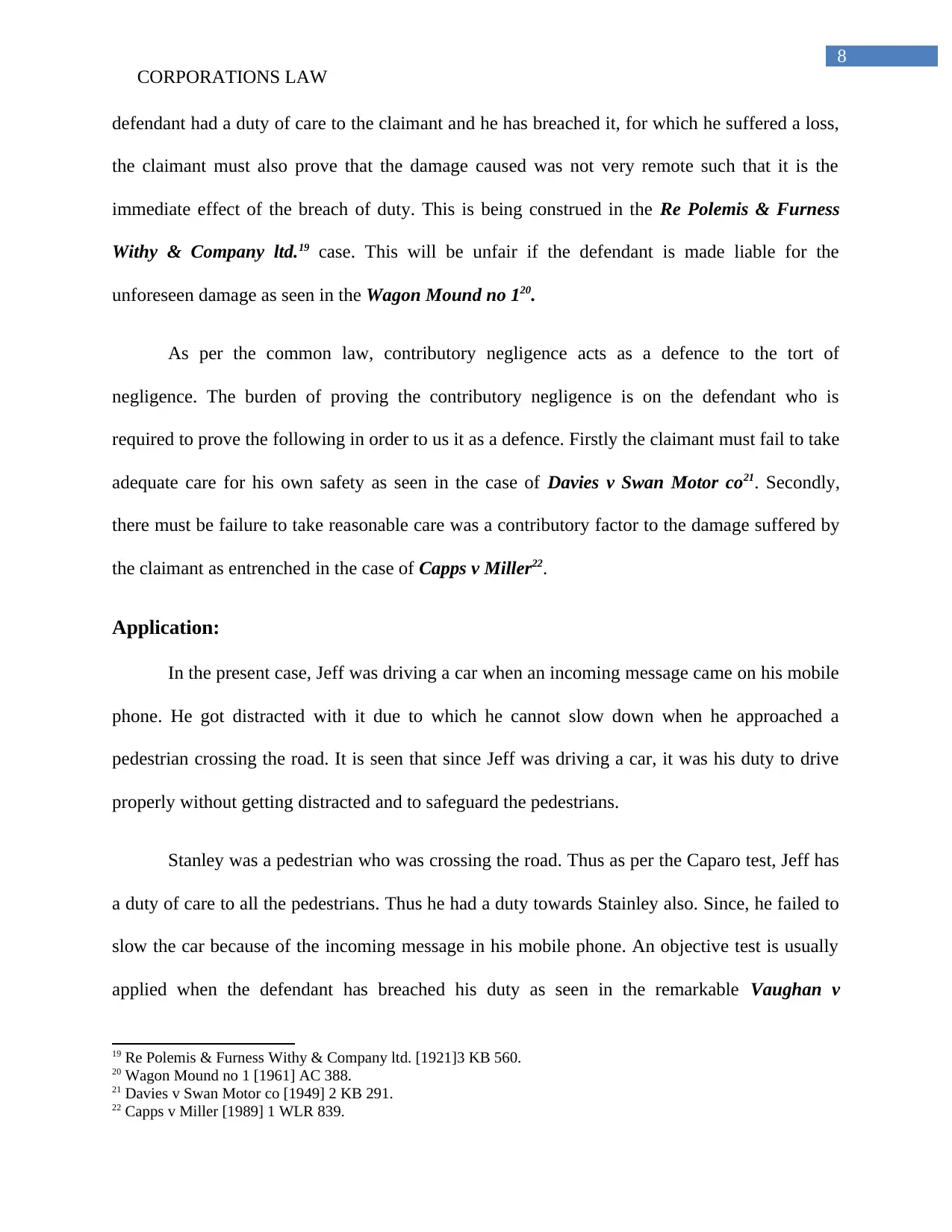
8
CORPORATIONS LAW
defendant had a duty of care to the claimant and he has breached it, for which he suffered a loss,
the claimant must also prove that the damage caused was not very remote such that it is the
immediate effect of the breach of duty. This is being construed in the Re Polemis & Furness
Withy & Company ltd.19 case. This will be unfair if the defendant is made liable for the
unforeseen damage as seen in the Wagon Mound no 120.
As per the common law, contributory negligence acts as a defence to the tort of
negligence. The burden of proving the contributory negligence is on the defendant who is
required to prove the following in order to us it as a defence. Firstly the claimant must fail to take
adequate care for his own safety as seen in the case of Davies v Swan Motor co21. Secondly,
there must be failure to take reasonable care was a contributory factor to the damage suffered by
the claimant as entrenched in the case of Capps v Miller22.
Application:
In the present case, Jeff was driving a car when an incoming message came on his mobile
phone. He got distracted with it due to which he cannot slow down when he approached a
pedestrian crossing the road. It is seen that since Jeff was driving a car, it was his duty to drive
properly without getting distracted and to safeguard the pedestrians.
Stanley was a pedestrian who was crossing the road. Thus as per the Caparo test, Jeff has
a duty of care to all the pedestrians. Thus he had a duty towards Stainley also. Since, he failed to
slow the car because of the incoming message in his mobile phone. An objective test is usually
applied when the defendant has breached his duty as seen in the remarkable Vaughan v
19 Re Polemis & Furness Withy & Company ltd. [1921]3 KB 560.
20 Wagon Mound no 1 [1961] AC 388.
21 Davies v Swan Motor co [1949] 2 KB 291.
22 Capps v Miller [1989] 1 WLR 839.
CORPORATIONS LAW
defendant had a duty of care to the claimant and he has breached it, for which he suffered a loss,
the claimant must also prove that the damage caused was not very remote such that it is the
immediate effect of the breach of duty. This is being construed in the Re Polemis & Furness
Withy & Company ltd.19 case. This will be unfair if the defendant is made liable for the
unforeseen damage as seen in the Wagon Mound no 120.
As per the common law, contributory negligence acts as a defence to the tort of
negligence. The burden of proving the contributory negligence is on the defendant who is
required to prove the following in order to us it as a defence. Firstly the claimant must fail to take
adequate care for his own safety as seen in the case of Davies v Swan Motor co21. Secondly,
there must be failure to take reasonable care was a contributory factor to the damage suffered by
the claimant as entrenched in the case of Capps v Miller22.
Application:
In the present case, Jeff was driving a car when an incoming message came on his mobile
phone. He got distracted with it due to which he cannot slow down when he approached a
pedestrian crossing the road. It is seen that since Jeff was driving a car, it was his duty to drive
properly without getting distracted and to safeguard the pedestrians.
Stanley was a pedestrian who was crossing the road. Thus as per the Caparo test, Jeff has
a duty of care to all the pedestrians. Thus he had a duty towards Stainley also. Since, he failed to
slow the car because of the incoming message in his mobile phone. An objective test is usually
applied when the defendant has breached his duty as seen in the remarkable Vaughan v
19 Re Polemis & Furness Withy & Company ltd. [1921]3 KB 560.
20 Wagon Mound no 1 [1961] AC 388.
21 Davies v Swan Motor co [1949] 2 KB 291.
22 Capps v Miller [1989] 1 WLR 839.
⊘ This is a preview!⊘
Do you want full access?
Subscribe today to unlock all pages.

Trusted by 1+ million students worldwide
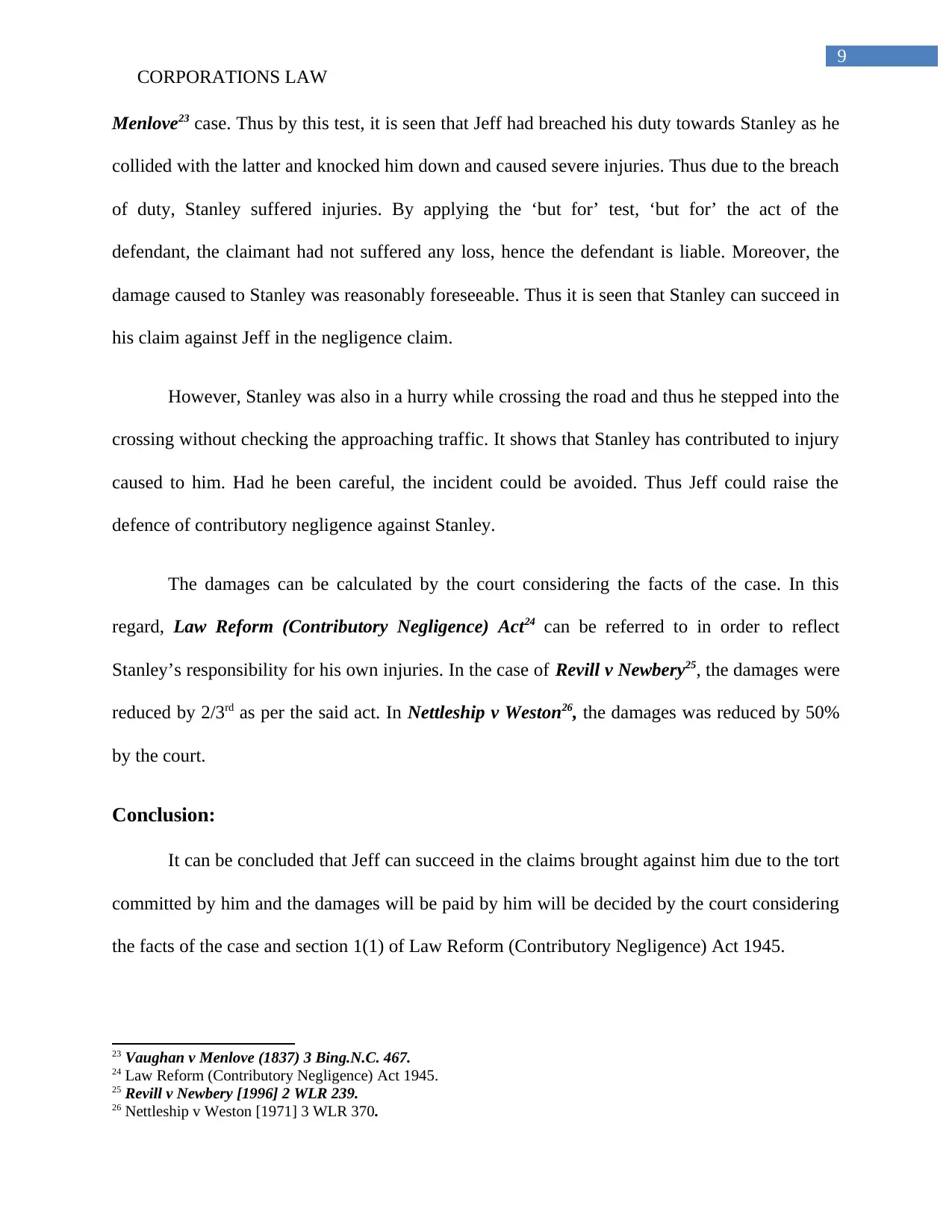
9
CORPORATIONS LAW
Menlove23 case. Thus by this test, it is seen that Jeff had breached his duty towards Stanley as he
collided with the latter and knocked him down and caused severe injuries. Thus due to the breach
of duty, Stanley suffered injuries. By applying the ‘but for’ test, ‘but for’ the act of the
defendant, the claimant had not suffered any loss, hence the defendant is liable. Moreover, the
damage caused to Stanley was reasonably foreseeable. Thus it is seen that Stanley can succeed in
his claim against Jeff in the negligence claim.
However, Stanley was also in a hurry while crossing the road and thus he stepped into the
crossing without checking the approaching traffic. It shows that Stanley has contributed to injury
caused to him. Had he been careful, the incident could be avoided. Thus Jeff could raise the
defence of contributory negligence against Stanley.
The damages can be calculated by the court considering the facts of the case. In this
regard, Law Reform (Contributory Negligence) Act24 can be referred to in order to reflect
Stanley’s responsibility for his own injuries. In the case of Revill v Newbery25, the damages were
reduced by 2/3rd as per the said act. In Nettleship v Weston26, the damages was reduced by 50%
by the court.
Conclusion:
It can be concluded that Jeff can succeed in the claims brought against him due to the tort
committed by him and the damages will be paid by him will be decided by the court considering
the facts of the case and section 1(1) of Law Reform (Contributory Negligence) Act 1945.
23 Vaughan v Menlove (1837) 3 Bing.N.C. 467.
24 Law Reform (Contributory Negligence) Act 1945.
25 Revill v Newbery [1996] 2 WLR 239.
26 Nettleship v Weston [1971] 3 WLR 370.
CORPORATIONS LAW
Menlove23 case. Thus by this test, it is seen that Jeff had breached his duty towards Stanley as he
collided with the latter and knocked him down and caused severe injuries. Thus due to the breach
of duty, Stanley suffered injuries. By applying the ‘but for’ test, ‘but for’ the act of the
defendant, the claimant had not suffered any loss, hence the defendant is liable. Moreover, the
damage caused to Stanley was reasonably foreseeable. Thus it is seen that Stanley can succeed in
his claim against Jeff in the negligence claim.
However, Stanley was also in a hurry while crossing the road and thus he stepped into the
crossing without checking the approaching traffic. It shows that Stanley has contributed to injury
caused to him. Had he been careful, the incident could be avoided. Thus Jeff could raise the
defence of contributory negligence against Stanley.
The damages can be calculated by the court considering the facts of the case. In this
regard, Law Reform (Contributory Negligence) Act24 can be referred to in order to reflect
Stanley’s responsibility for his own injuries. In the case of Revill v Newbery25, the damages were
reduced by 2/3rd as per the said act. In Nettleship v Weston26, the damages was reduced by 50%
by the court.
Conclusion:
It can be concluded that Jeff can succeed in the claims brought against him due to the tort
committed by him and the damages will be paid by him will be decided by the court considering
the facts of the case and section 1(1) of Law Reform (Contributory Negligence) Act 1945.
23 Vaughan v Menlove (1837) 3 Bing.N.C. 467.
24 Law Reform (Contributory Negligence) Act 1945.
25 Revill v Newbery [1996] 2 WLR 239.
26 Nettleship v Weston [1971] 3 WLR 370.
Paraphrase This Document
Need a fresh take? Get an instant paraphrase of this document with our AI Paraphraser
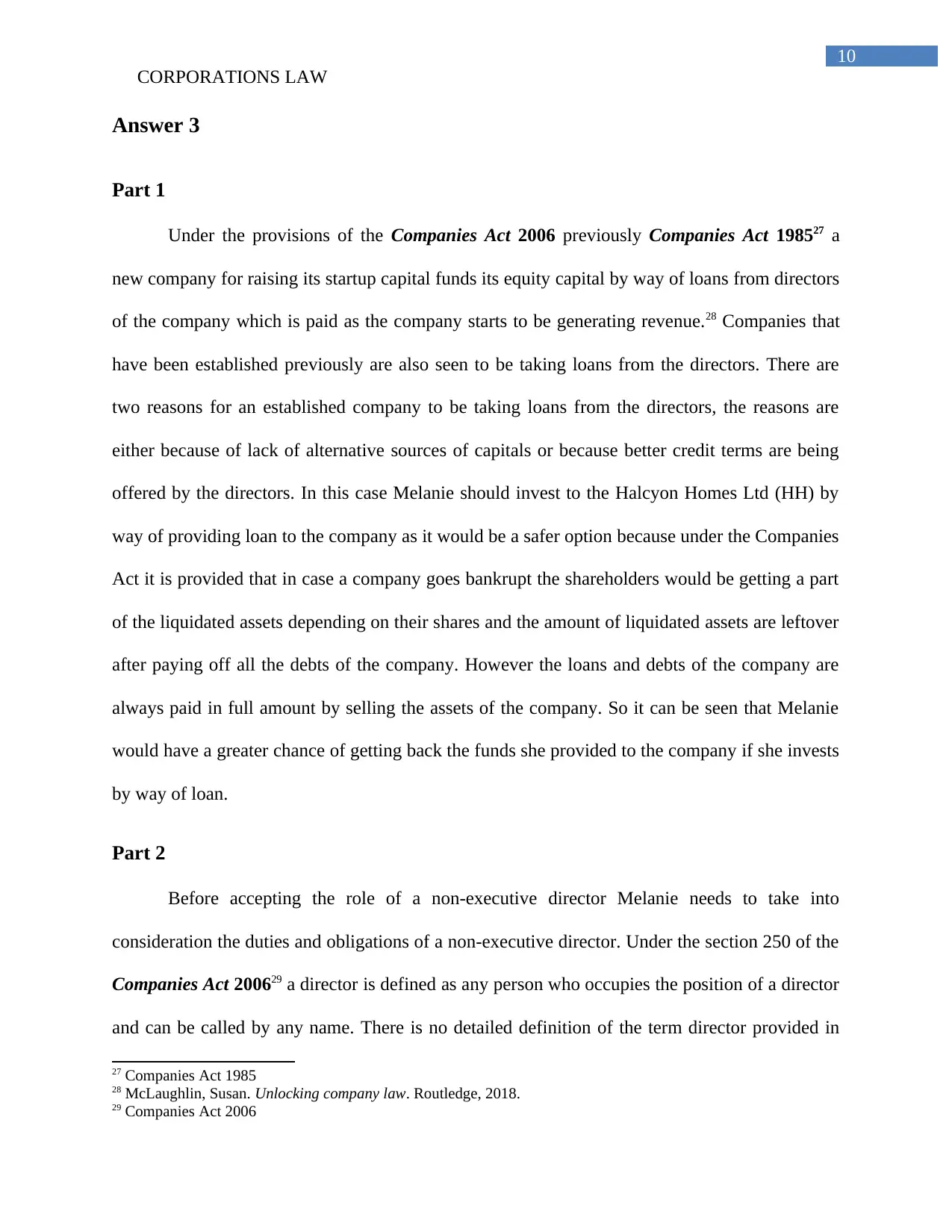
10
CORPORATIONS LAW
Answer 3
Part 1
Under the provisions of the Companies Act 2006 previously Companies Act 198527 a
new company for raising its startup capital funds its equity capital by way of loans from directors
of the company which is paid as the company starts to be generating revenue.28 Companies that
have been established previously are also seen to be taking loans from the directors. There are
two reasons for an established company to be taking loans from the directors, the reasons are
either because of lack of alternative sources of capitals or because better credit terms are being
offered by the directors. In this case Melanie should invest to the Halcyon Homes Ltd (HH) by
way of providing loan to the company as it would be a safer option because under the Companies
Act it is provided that in case a company goes bankrupt the shareholders would be getting a part
of the liquidated assets depending on their shares and the amount of liquidated assets are leftover
after paying off all the debts of the company. However the loans and debts of the company are
always paid in full amount by selling the assets of the company. So it can be seen that Melanie
would have a greater chance of getting back the funds she provided to the company if she invests
by way of loan.
Part 2
Before accepting the role of a non-executive director Melanie needs to take into
consideration the duties and obligations of a non-executive director. Under the section 250 of the
Companies Act 200629 a director is defined as any person who occupies the position of a director
and can be called by any name. There is no detailed definition of the term director provided in
27 Companies Act 1985
28 McLaughlin, Susan. Unlocking company law. Routledge, 2018.
29 Companies Act 2006
CORPORATIONS LAW
Answer 3
Part 1
Under the provisions of the Companies Act 2006 previously Companies Act 198527 a
new company for raising its startup capital funds its equity capital by way of loans from directors
of the company which is paid as the company starts to be generating revenue.28 Companies that
have been established previously are also seen to be taking loans from the directors. There are
two reasons for an established company to be taking loans from the directors, the reasons are
either because of lack of alternative sources of capitals or because better credit terms are being
offered by the directors. In this case Melanie should invest to the Halcyon Homes Ltd (HH) by
way of providing loan to the company as it would be a safer option because under the Companies
Act it is provided that in case a company goes bankrupt the shareholders would be getting a part
of the liquidated assets depending on their shares and the amount of liquidated assets are leftover
after paying off all the debts of the company. However the loans and debts of the company are
always paid in full amount by selling the assets of the company. So it can be seen that Melanie
would have a greater chance of getting back the funds she provided to the company if she invests
by way of loan.
Part 2
Before accepting the role of a non-executive director Melanie needs to take into
consideration the duties and obligations of a non-executive director. Under the section 250 of the
Companies Act 200629 a director is defined as any person who occupies the position of a director
and can be called by any name. There is no detailed definition of the term director provided in
27 Companies Act 1985
28 McLaughlin, Susan. Unlocking company law. Routledge, 2018.
29 Companies Act 2006
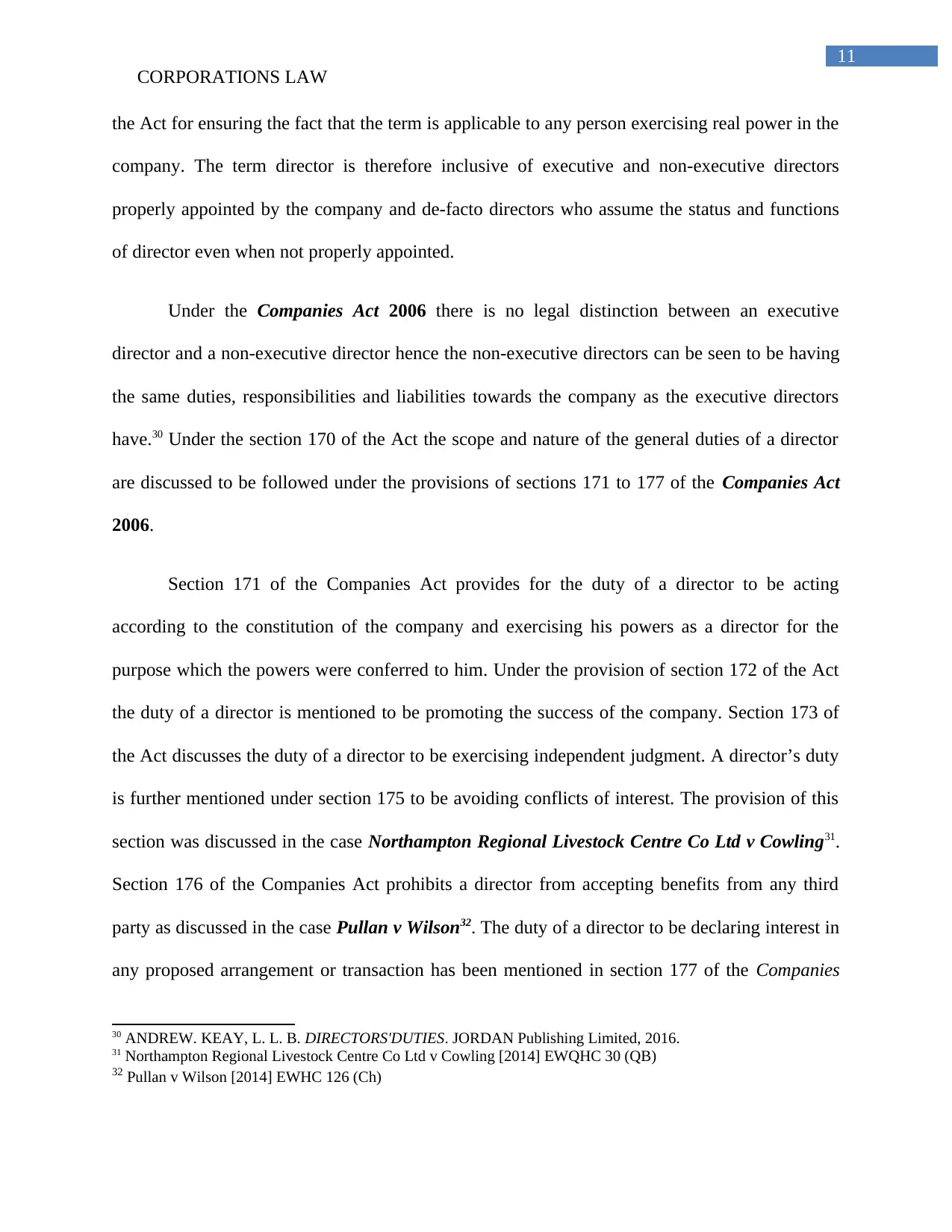
11
CORPORATIONS LAW
the Act for ensuring the fact that the term is applicable to any person exercising real power in the
company. The term director is therefore inclusive of executive and non-executive directors
properly appointed by the company and de-facto directors who assume the status and functions
of director even when not properly appointed.
Under the Companies Act 2006 there is no legal distinction between an executive
director and a non-executive director hence the non-executive directors can be seen to be having
the same duties, responsibilities and liabilities towards the company as the executive directors
have.30 Under the section 170 of the Act the scope and nature of the general duties of a director
are discussed to be followed under the provisions of sections 171 to 177 of the Companies Act
2006.
Section 171 of the Companies Act provides for the duty of a director to be acting
according to the constitution of the company and exercising his powers as a director for the
purpose which the powers were conferred to him. Under the provision of section 172 of the Act
the duty of a director is mentioned to be promoting the success of the company. Section 173 of
the Act discusses the duty of a director to be exercising independent judgment. A director’s duty
is further mentioned under section 175 to be avoiding conflicts of interest. The provision of this
section was discussed in the case Northampton Regional Livestock Centre Co Ltd v Cowling31.
Section 176 of the Companies Act prohibits a director from accepting benefits from any third
party as discussed in the case Pullan v Wilson32. The duty of a director to be declaring interest in
any proposed arrangement or transaction has been mentioned in section 177 of the Companies
30 ANDREW. KEAY, L. L. B. DIRECTORS'DUTIES. JORDAN Publishing Limited, 2016.
31 Northampton Regional Livestock Centre Co Ltd v Cowling [2014] EWQHC 30 (QB)
32 Pullan v Wilson [2014] EWHC 126 (Ch)
CORPORATIONS LAW
the Act for ensuring the fact that the term is applicable to any person exercising real power in the
company. The term director is therefore inclusive of executive and non-executive directors
properly appointed by the company and de-facto directors who assume the status and functions
of director even when not properly appointed.
Under the Companies Act 2006 there is no legal distinction between an executive
director and a non-executive director hence the non-executive directors can be seen to be having
the same duties, responsibilities and liabilities towards the company as the executive directors
have.30 Under the section 170 of the Act the scope and nature of the general duties of a director
are discussed to be followed under the provisions of sections 171 to 177 of the Companies Act
2006.
Section 171 of the Companies Act provides for the duty of a director to be acting
according to the constitution of the company and exercising his powers as a director for the
purpose which the powers were conferred to him. Under the provision of section 172 of the Act
the duty of a director is mentioned to be promoting the success of the company. Section 173 of
the Act discusses the duty of a director to be exercising independent judgment. A director’s duty
is further mentioned under section 175 to be avoiding conflicts of interest. The provision of this
section was discussed in the case Northampton Regional Livestock Centre Co Ltd v Cowling31.
Section 176 of the Companies Act prohibits a director from accepting benefits from any third
party as discussed in the case Pullan v Wilson32. The duty of a director to be declaring interest in
any proposed arrangement or transaction has been mentioned in section 177 of the Companies
30 ANDREW. KEAY, L. L. B. DIRECTORS'DUTIES. JORDAN Publishing Limited, 2016.
31 Northampton Regional Livestock Centre Co Ltd v Cowling [2014] EWQHC 30 (QB)
32 Pullan v Wilson [2014] EWHC 126 (Ch)
⊘ This is a preview!⊘
Do you want full access?
Subscribe today to unlock all pages.

Trusted by 1+ million students worldwide
1 out of 24
Related Documents
Your All-in-One AI-Powered Toolkit for Academic Success.
+13062052269
info@desklib.com
Available 24*7 on WhatsApp / Email
![[object Object]](/_next/static/media/star-bottom.7253800d.svg)
Unlock your academic potential
Copyright © 2020–2025 A2Z Services. All Rights Reserved. Developed and managed by ZUCOL.





